Abstract
In recent years, multi-functional lecture halls have developed rapidly and become a symbol of contemporary public spaces and places. This kind of spatial facility that brings together the advantages of land intensiveness and multi-functional integration also faces feedback such as poor acoustic effects. However, current research rarely involves the architectural design perspective, which is actually the root consideration of this problem; that is, how to set up corresponding spatial layout measures to optimize acoustic performance in a relatively economical and simple way. This study uses the academic lecture hall of the School of Architecture and Planning of Yunnan University as a case to try to solve these problems. The research is based on holistic considerations, starting from site selection, architectural design, aesthetic considerations, and environmental noise assessment, and combining simulation results with actual measurement results. Using a prediction–comparison–verification method, key acoustic parameters such as speech intelligibility, loudness, and reverberation time were calculated and evaluated to understand the acoustic design problems of the hall. The study found that the out-of-control reverberation time was the main cause of poor acoustic feedback, and based on this, optimization and transformation were carried out from an architectural perspective. Finally, a renovation suggestion was made that the application of sound-absorbing materials on the rear wall can achieve better acoustic effects inside the hall. Among the space combination methods, the combination of “rear wall, central ceiling, and front ceiling” has the best effect. Practical insights are provided for improving the acoustic performance of the multi-functional lecture halls while taking into account the acoustic design and feasible requirements.
1. Introduction
Multi-functional lecture halls and comprehensive auditoriums have emerged as pivotal components within contemporary infrastructural developments. Particularly in locales characterized by land scarcity and fiscal prudence, the establishment of expansive facilities endowed with acoustically refined attributes to accommodate large gatherings stands as a judicious choice. This architectural typology finds expression in educational institutions and municipal entities (Liang et al., 2021) [1], wherein these spaces are meticulously crafted to facilitate a myriad of activities ranging from scholarly discourse and deliberative sessions, to the dissemination of lectures and presentations, alongside provision for multimedia engagement and training endeavors. For instance, the Clifton Court Hall within the precincts of the University of Cincinnati’s College of Arts and Sciences exemplifies a pivotal nexus for scholarly dialogue and communal interaction, fostering an array of communal and collaborative zones alongside dedicated team rooms (Bennett, 2001) [2].
Against the backdrop of burgeoning higher education pursuits in developing nations, the exigencies placed upon academic lecture halls within university settings have witnessed an augmenting trajectory, both in terms of functional efficacy and spatial magnitude [3]. In China, in particular, it has been seen that the construction of lecture halls has peaked in the last two decades, and much new research has been generated on how to design these venues [4,5]. Budiaková [6,7] and Zhao Juan [8] proposed the optimization design strategy of lecture halls from the perspective of ventilation, Chen Xi [3] proposed the design guidance for academic lecture halls in universities from the perspective of environmental design, and Huang Hui [9] kept eyes on the topic of the spatial design of lecture halls. However, in recent years, the number of publications in this field in China has been decreasing year by year and this topic is seemingly getting less attention than before (see Figure 1 below). In an era of rapidly changing materials and technologies, the reclaiming of the academic lecture hall is an issue that needs to be emphasized by architectural researchers.
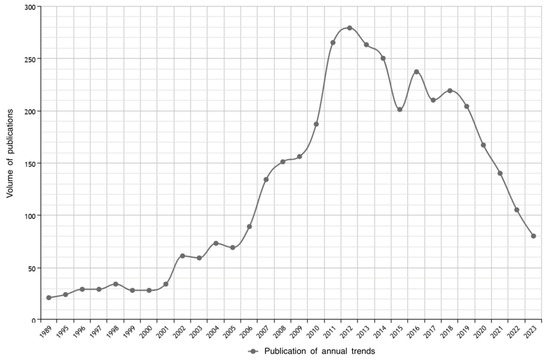
Figure 1.
The number of studies on hall buildings in China has declined in recent years.
Meanwhile, due to the specific use of lecture halls, most countries have comprehensive or specialized codes designed to guide architects in creating the best acoustical environment in these spaces. These guidelines, such as those outlined by the World Health Organization (WHO, 1999) [10], the Architectural Institute of Japan (Fukuchi & Ueno, 2004) [11], the Australian/New Zealand Standard [12], and the German Institute for Standardization [13], advocate for high levels of acoustic absorption and short reverberation times to enhance speech clarity within lecture halls. China’s current reference model, GB/T50356-2005 “Code for architectural acoustical design of theater, cinema and multi-use auditorium” [14], emphasizes these principles in the architectural acoustical design of theaters, cinemas, and multi-use auditoriums.
However, despite the existence of acoustic code guidance, numerous academic surveys and reports continue to find discrepancies between expected and actual results in terms of acoustic performance in these venues. They have emphasized that there is a gap between the expected and actual results in these venues, particularly in terms of acoustic performance, which often falls short of expectations. Nassiri [15] investigated the background noise levels in university classrooms through a study that was largely substandard, revealing deficiencies in acoustics. Escobar [16] analyzed the acoustic parameters of a university auditorium and multi-functional conference room and proposed improvements accordingly. Pinho [17] examined the acoustical performance of school buildings in Portugal, elucidating prevalent issues. Sala and Rantala [18] investigated acoustics and activity noise in school classrooms in Finland, amplifying concerns regarding ambient noise levels. Ricciardi and Buratti [19] conducted an objective and subjective assessment of acoustic comfort in classrooms, combining perceived and actual conditions to evaluate the acoustic effectiveness of classrooms. In addition, van den Heuij [20] evaluated the acoustic effectiveness of academic classrooms through existing acoustic reference levels, pointing out where the existing deficiencies lie. Astolfi [21] provides a summary of recent developments in classroom acoustics and describes the effects of noise on students and lecturers. However, at the same time, the researcher points out that further research is needed for this complex communication scenario.
Many Chinese researchers have also studied these deficiencies. For example, as a leading expert in this field, Kang Jian [22] has conducted a lot of research on acoustics in Chinese venues. Xie Hui [23] emphasizes the importance of the acoustic environment of lecture halls and puts forward the suggestion of improving the acoustic environment of lecture halls by changing the decorative materials and design on a larger scale. Wang Chao [24] conducted a time-varying analysis of the acoustic effects of very large spaces, especially public transportation spaces. Yan Xiang [25] specifically took the renovation of the lecture hall of Tsinghua University as an example to explain the dilemma of multi-functional lecture halls and proposed that architectural acoustic adaptive design should be carried out based on more detailed acoustic functional requirements. These mainly provide guidance for the design and remodeling of lecture halls in the institutions of higher education from the technical level, but these high-investment optimization options are relatively difficult to achieve in many areas, with limited referentiality. That is to say, only by the in-depth consideration of the relationship between building renovation and the conditions and needs of the building can we better improve the acoustic performance of the building and promote the introduction of more applicable and reasonable specifications.
The problems that have been pointed out and still exist in the studies above show that a large number of halls have problems with inaudibility and how to improve it in a simpler way. To this end, the authors conducted a questionnaire survey of the academic lecture hall of the School of Architecture and Planning at Yunnan University. It found that 131 of the 200 students surveyed (more than 65%) indicated that they were dissatisfied with the current acoustic conditions. Only 24 students, representing 12% of the sample size, expressed satisfaction.
Therefore, this study takes this hall as an example, which has similar problems. This research uses a combination of experimental testing and computer software simulation to carry out acoustic environment design research through the use of the acoustic simulation software EASE 4.4 digital modeling of the hall. Testing with the material parameters and environmental noise, it analyzes the data on loudness, speech intelligibility, reverberation time, and other indicators. Later, this research studies their structural characteristics and indicate the problems existing in the acoustic environment design of this kind of college lecture hall. Then, the acoustic environment design transformation program is proposed and verified by software simulation to achieve sound quality optimization so that the academic lecture hall can meet the normal use requirements.
2. Overview and Material Test
2.1. Building Introduction
Yunnan University at college town located in Chenggong New City Area accommodates over 20,000 students and staff, with a total construction area of about 1,029,000 square meters. However, the fact that most of them are located in mountainous areas means that the buildings have to be relatively compact. The multi-functional use of space became inevitable. The academic lecture hall, situated within the School of Architecture and Planning at Yunnan University, on the inside of the college building, surrounded by sloping land, was finalized in 2010.
It was primarily serving as a venue for conferences, academic discourse, and student engagements. It spans approximately 24 m in length, 16.8 m in width, and boasts a net height of 8.1 m in architectural design dimensions. The hall occupies a rectangular footprint encompassing 403.2 square meters, with a volumetric capacity of around 2857.68 cubic meters. It accommodates a total of 302 seats, averaging 9.46 cubic meters per seat. Notably, the hall features a length of 18 m accessible to the audience (of a total of 24 m), with seating arranged in a tiered fashion, comprising 12 rows and 3 columns (13 rows in the central column), each row accommodating 24 seats, incrementally elevated by 0.1 m.
To mitigate potential noise disruptions, the lecture hall strategically aligns with the eastern courtyard of the college, ensuring minimal interference with daily instructional activities. Accessible through the ground floor main entrance of the college, a passageway connects the hall to the college atrium, while a rear entrance facilitates ingress and egress directly to the lecture hall (see Figure 2c).


Figure 2.
Aerial view from drone (a), architectural models formed by drone mapping and on-site surveys (b), and basic situation map of Yunnan University School of Architecture and Planning (c).
Generally, the spatial layout of the auditorium is often in the form of theater architecture (rectangular, polygonal, fan-shaped, curved, etc.). However, the most important prerequisite for the audience layout in the academic lecture hall is to ensure clear vision and clear sound at the same time. Therefore, there are few balcony seats in the academic lecture hall, and the spatial form of the auditorium has some little changes. Different from professional opera houses, etc., due to many constraints such as land scarcity and financial constraints, the use of a relatively simple rectangular plane is the strategy currently widely used in such places. The sound nature of the lecture hall is mainly electro-acoustic (a combination of microphones and speakers), and the sound propagation is optimized based on the internal decoration and the acoustic properties of the materials.
2.2. Software Introduction
We used EASE 4.4 digital modeling software to model the lecture hall. In this software, buildings can be constructed as a 2D surface using line elements firstly. These 2D surfaces can then be extruded to create a 3D model. Additionally, the software allows us to match materials from its library to the corresponding materials in the 3D model. Then, we analyzed the building by EASE (a software developed by Ahnert Feistel Media Group, Berlin, Germany), which is widely used in electro-acoustic simulation. The material library of EASE is complete and can be converted with other software file formats.
The sound effect of the hall is related to the shape of the material, etc., and the basic status quo of the hall can be simulated by EASE to obtain the relevant situation of each acoustic parameter. The basic steps of measurement using the EASE 4.4 are as follows: 3D modeling, inputting acoustic parameters such as sound-absorbing materials, and then outputting acoustic parameters such as speech intelligibility [26].
Before the data analysis of loudness, reverberation time, speech intelligibility, and other indicators, according to the above design drawings and measured dimensions, first of all, the academic lecture hall were modeled [27]. We set the main structure of the lecture hall walls, columns, and other structures according to the previous CAD computer-aided design drawings of the plan and section; then the indoor stage and seats were input in further detail; finally, the corresponding materials were given to the lecture hall. Then, the listening surface (bright yellow) was set—featuring blue chairs representing acoustic simulation listening points (receivers), parallelograms delineating listening areas, and red horn patterns symbolizing sound sources within the lecture hall (see Figure 3).

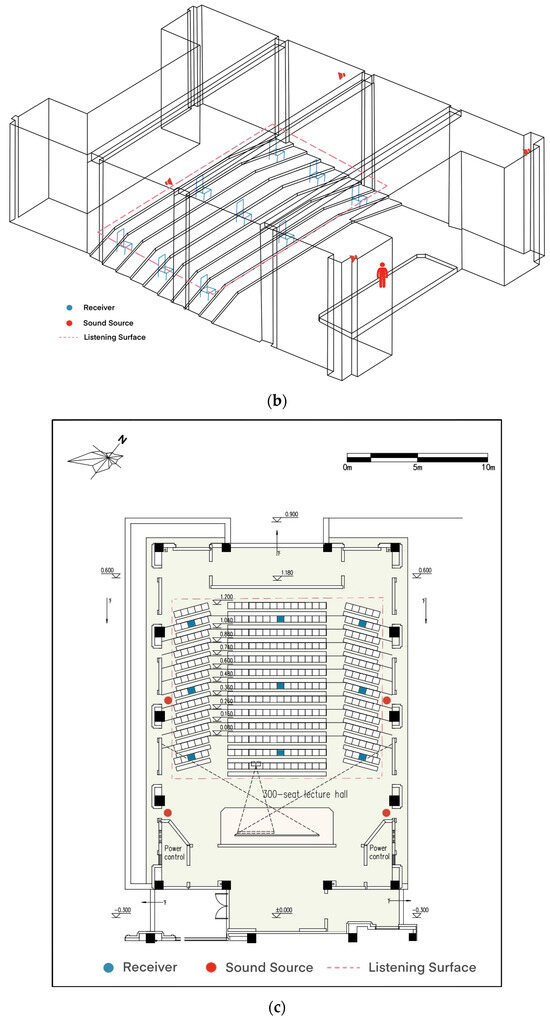

Figure 3.
Lecture hall drawing model in 3D (a), EASE model (b), lecture hall plan (c), and lecture hall section (d).
The model construction entails several other steps (flow chart in Figure 4):
- (1)
- Importing a three-dimensional model into the EASE software 4.4 based on the actual dimensions;
- (2)
- Conducting inspections for sound leakage and boundary surface irregularities;
- (3)
- Configuring interface absorption coefficients for the model (as detailed in Table 1, the acoustic absorption index of decoration materials in the academic lecture hall);
- (4)
- Implementing stage sound settings corresponding to the lecture theater’s actual BD-H1086 sound usage;
- (5)
- Generating sound simulation diagrams.

Figure 4.
EASE software acoustic setting flow chart (taking reverberation time test as an example).

Table 1.
Acoustic absorption index of decoration materials in academic lecture hall.
Table 1.
Acoustic absorption index of decoration materials in academic lecture hall.
| Name of Material | Frequency/Hz | ||||||
| 125 | 250 | 500 | 1000 | 2000 | 4000 | ||
| 1 | Hardwood flooring (WOOD FLR) | 0.20 | 0.15 | 0.10 | 0.08 | 0.08 | 0.05 |
| 2 | Smooth tile (CORTEGA) | 0.31 | 0.32 | 0.51 | 0.72 | 0.74 | 0.77 |
| 3 | Empty seats (MTSEAT FAB) | 0.19 | 0.37 | 0.56 | 0.67 | 0.61 | 0.59 |
| 4 | Audience with thick cushions (PUBLIC TKC) | 0.50 | 0.70 | 0.85 | 0.95 | 0.95 | 0.90 |
| 5 | A 12.5 mm thick plasterboard with 3 cm backspace (GYP125MM) | 0.30 | 0.20 | 0.05 | 0.02 | 0.02 | 0.02 |
| 6 | A 90/15 mm wood grid with 6 cm backspace (WOOD GRID1) | 0.10 | 0.36 | 0.99 | 0.99 | 0.50 | 0.35 |
| 7 | Dual pane glass (WINDOW DP) | 0.25 | 0.10 | 0.07 | 0.06 | 0.04 | 0.02 |
| 8 | Soundproof solid wood door (DOOR HOLLOW) | 0.15 | 0.10 | 0.06 | 0.08 | 0.10 | 0.05 |
| 9 | Perforated Plate (PERFPANEL1) | 0.78 | 0.58 | 0.27 | 0.15 | 0.04 | 0.12 |
2.3. Material Acoustic Performance Testing
2.3.1. Introduction to Material Distribution Location
In terms of the overall environmental material settings, the following configuration is adopted (see Figure 5). The academic lecture hall incorporates a highly sound-absorbing structure on both the back of the stage and the rear wall of the auditorium, effectively reducing sound focus, echo problems, and microphone feedback. This design choice also serves to reduce reverberation time and control unwanted echoes. The use of environmentally friendly E1 fire-rated A1 grooved wood acoustic panels for the stage back wall and rear side walls further enhances sound absorption and propagation efficiency. Using a standardized modular design and slot-and-keel construction, these panels facilitate optimum sound transmission within the hall (shown as ① in Figure 5).
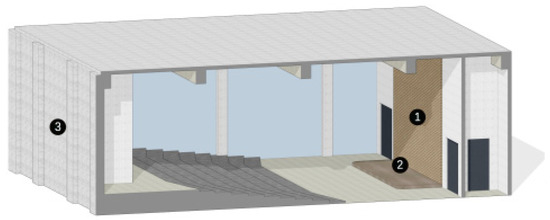
Figure 5.
Schematic design of acoustic environment decoration.
In order to meet the requirements for floor noise insulation and vibration damping, the academic lecture hall uses a timber floor layout—with a primary frame structure consisting of 50 mm × 50 mm timber keels spaced at 400 mm intervals. In addition, a comprehensive application of burnt carbon slag sound insulation layer further enhances sound transmission attenuation, thereby optimizing audience perception quality (shown as ② in Figure 5).
Externally, the walls of the auditorium are constructed of dry-hung stone (the facing stone is hung directly onto the external surface of the building structure, leaving a 40–50 mm cavity between the stone and the structure), which increases structural stability and improves acoustic insulation. To ensure balanced sound dispersion, loudspeakers are strategically positioned on either side of the stage wall and along the center of the side walls, promoting an even distribution of sound pressure throughout the venue. This configuration aims to improve the overall listening experience for the audience, providing a comfortable and high-quality listening environment (shown as ③ in Figure 5).
2.3.2. Sound Absorption Performance Experiment
We selected the decorative materials in the auditorium and determined their sound absorption coefficients in the laboratory. This was followed by a computerized acoustic simulation. EASE’s material editor provides a variety of materials commonly used in rooms, and new sound-absorbing materials can be edited and added as needed. In the simulation, we set the absorption coefficients of the materials according to the specific data measured in the experiment.
The absorption coefficient of acoustic materials is usually determined by the reverberation chamber method or the standing wave tube method [28,29]. The aforementioned method is predominantly utilized in engineering measurements; however, owing to its substantial requirement for sample area, the practical sample area frequently falls short of the necessary size, potentially resulting in significant discrepancies in test outcomes. On the contrary, the impedance tube method simplifies the measurement process because it requires a small sample area and the sound wave is incident perpendicularly to the sample surface, and is more suitable for sound absorption coefficient testing in the laboratory [30]. The sound absorption coefficient tested by this method complies with the national standard [31] (Acoustics: Measurement of sound absorption in a reverberation room), and is accepted by the EASE software 4.4 material parameter input terminal standard.
In order to determine the absorption coefficient of the auditorium material, we used the AWA62902 standing wave tube equipment set (shown in Figure 6). For this material testing, we used two sets of tubes to cover the frequency range from 125 to 4000 Hz. Among them, the larger tube specification is Φ96 × 1000 (mm), and the frequency range is 90 Hz~2075 Hz; the smaller tube specification is Φ30 × 350 (mm), and the frequency range is 1500 Hz~6641 Hz.
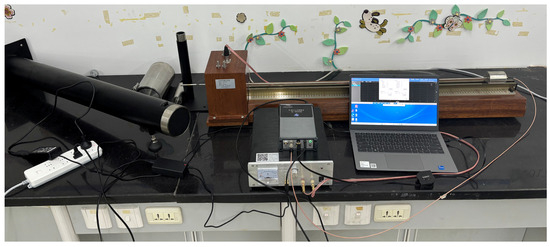
Figure 6.
Standing wave tube experimental equipment for measuring sound absorption coefficient.
We first calibrated the sensitivity level using the standard material module to ensure it reads 93.8 dB at 1 kHz. We then installed the samples of different materials (the spatial distribution of the materials is shown in Figure 7, and the material names are shown in Table 1) at one end of the standing wave tube, and provided different frequency sound waves in the range of 125 to 4000 Hz to each material through a signal generator. Next, we measured the minimum and maximum values of the sound pressure amplitude in the system, and calculated the absorption coefficient of each material at different frequencies based on the standing wave ratio method. The test results are shown in Table 1.
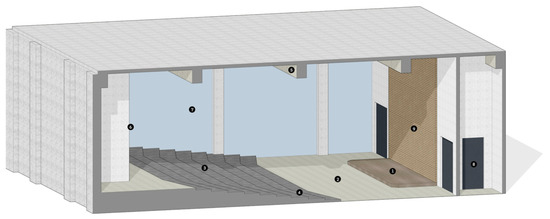
Figure 7.
Distribution of the materials in the lecture hall.
2.4. On-Site Measurement Arrangement and Noise Testing
Environmental noise (background noise) is a physical quantity closely related to indoor noise interference. It refers to the sum of environmental noise contributed by other sound sources other than the measured sound source. Conducting this test can test whether the doors, windows, walls, floors, and partitions of the equipment room in the lecture hall have sufficient sound insulation capabilities, and can also test the extent to which the lecture hall is affected by external environmental noise and instrument noise. In this regard, Zhu Peisheng’s [32] research shows the correlation between reverberation time, background noise and environmental factors, and further strengthens the above view. It is believed that before conducting on-site testing and site acoustic effect simulation, it is necessary to test the indoor acoustic environment, and it is important to understand its impact on the acoustic environment as an irrelevant parameter.
In this paper, the researchers used DT-859B Professional Multi-functional Environmental Test Meter as the measuring instrument, which was newly launched in 2022 to assess the acoustical parameters in the unoccupied condition. We evenly distributed measurement points along one side of the hall at a height of 1.2 m, as illustrated in Figure 8 (bright yellow schematic surface); the plan and section are shown in Figure 3. These points were strategically positioned to encompass representative areas such as the front, middle, and back of the audience area, as well as the left, middle, and right sections of the hall. The test results revealed that the highest background noise level recorded at these measurement points in the academic lecture hall was 34.0 dB in pressure level (see Table 2), aligning with the background noise limits specified in GB/T50356-2005. The acoustic measurement findings affirm compliance with design specifications and the suitability of the venue for its intended use.

Figure 8.
Distribution of the points in the lecture hall and the sound level meter DT-859B.

Table 2.
Comparison of actual (hall) and normative (NR-30) values of background noise pressure level.
Subsequently, the measured average background noise levels were manually inputted into the EASE 4.4, incorporating the background noise sound pressure level for each frequency band.
3. Results
In the code GB/T50356-2005 of China [14], it is clearly stated that reverberation time and loudness are important factors in judging lecture halls; at the same time, the Australian/New Zealand Standard [12] also mentions that speech intelligibility in lecture halls can be improved by altering the reverberation time. China’s current reference model standards [14] for the architectural acoustic design of theaters, movie theaters, and multi-purpose auditoriums emphasize the effects of reverberation time, loudness, and speech intelligibility on indoor sound quality. Therefore, an acoustic analysis is necessary if an ideal lecture hall is to be built.
During the acoustic measurement and simulation process, we analyzed and compared the acoustic parameters defined in the standard [14], including reverberation time (T30), loudness, and the sound transmission index (STI) of speech intelligibility.
3.1. Speech Intelligibility
The main purpose of using a sound reinforcement system in a lecture hall is to expand the language sound to ensure that the auditorium has sufficient speech intelligibility (language clarity) at some sound pressure levels. Therefore, the design of the sound reinforcement system fundamentally revolves around optimizing speech intelligibility as the central focus [33]. This entails the careful consideration of electro-acoustic properties, maximum sound pressure levels (Max SPL), transmission frequency characteristics, sound distribution, audio gain, system noise, and other pertinent technical indicators. The core of solving the problem of unclear hearing reported by students (see in Section 1) is to check whether the language intelligibility settings are reasonable. In summary, acoustic issues based on speech intelligibility in the lecture hall still rely on further actual measurement and analysis.
3.1.1. Speech Intelligibility Simulation
The speech intelligibility index serves as a metric to quantify the degree of the intelligibility of spoken language within a given space. The indicators for evaluating indoor speech intelligibility include definition (D50), clarity (C50), sound transmission index (STI), etc. [34]. Bradley [35] established the linear relationship between C50 and STI under three noise-free reverberation conditions. The results show that the linear regression results of C50 and STI are better, and the degree of fitting between the two is higher. Sato [36] discussed the relationship between C50, D50, and STI—the results show that C50 and D50 can only be a simple substitute for STI, while STI is a more comprehensive indicator. Therefore, this simulation uses STI to evaluate indoor speech intelligibility.
In the EASE 4.4, the Speech Transmission Index (STI) method is used to calculate the speech intelligibility, which computes the expected value index based on architectural acoustics through resembling the reverberation time frequency response curve, and ensures that all loudspeakers are operating under normal conditions. The STI method is a rapid approach for objectively evaluating speech intelligibility in halls, contingent upon meeting the following prerequisites:
- (1)
- Essentially linear speech transmission, devoid of clipping or distortion.
- (2)
- Broadband speech transmission spanning typical frequencies of 125–4000 Hz, as this method assumes an unrestricted speech spectrum.
- (3)
- Background noise devoid of pure tones and lacking distinct peaks or valleys in the octave band spectrum.
- (4)
- The absence of impulse characteristics in the background noise.
- (5)
- Consistency in reverberation time across different frequencies.
The rating criteria for the speech intelligibility index (STI) are outlined in the following Table 3.

Table 3.
Criteria for rating the speech intelligibility index (STI).
As depicted in the figure below, the academic lecture hall has a low level of speech intelligibility, and the average STI index value for it was determined to be 0.549. As shown on the right side of Figure 9, the maximum value of STI does not exceed 0.578 and the minimum value is only 0.530. The abscissa of the right figure in Figure 9 is the STI value, and the ordinate is the weight. For example, nearly 30% of the test points have an STI assignment of about 0.54, while the corresponding maximum value point (0.578) only has less than 3% of the area. The entire curve is plump in the middle, and the maximum and minimum values account for a small proportion. It shows that the test results have strong universality and uniform performance.

Figure 9.
Analysis of the STI speech intelligibility calculations for the academic lecture hall.
Corresponding to a sound quality grade of F, this finding deviates somewhat from the standard STI value (supposed to be D at least for the lecture hall in Table 3).
3.1.2. Speech Intelligibility Measurement
Student volunteers were mobilized to execute speech intelligibility experiments within the lecture hall. Before each experiment, the volunteers were positioned in designated test areas and instructed to utilize standardized pronunciation. Subsequently, syllable articulation within the room was evaluated by analyzing feedback from the volunteers. The calculation formula for this assessment is outlined as follows:
A total of 37 student volunteers participated in the test (9 for each time), during which 50 syllables were pronounced at the designated test site. Subsequently, 37 test lists were issued, all of which were duly recovered, rendering 37 valid lists for analysis. The syllable articulation was then averaged and compared against the reference table. The results revealed that the syllable articulation within the lecture hall averaged at 72%, indicating a listening experience that is barely acceptable (Table 4). Consequently, at the subjective assessment level, the hall’s performance essentially meets the requirements for normal language usage. However, it aligns with the general information obtained from simulations, corresponding to a level of “complex information, familiar context (E/F/G)”.

Table 4.
Relationship between syllable articulation and listening perception.
Therefore, there is still a lot of room for improvement, and we hope to explore the possibility of improvement through the two most direct influencing quantities, loudness and reverberation time.
3.2. Loudness
W. Sabine, a pioneer in the field of architectural acoustics, underscored in his book “Reverberation” the significance of achieving sufficient loudness in a hall for optimal sound quality. In the context of a lecture hall, ensuring adequate loudness during normal use is a primary objective of sound quality design [37]. Consequently, loudness emerges as a pivotal indicator for assessing the sound quality of the hall and warrants careful consideration in the evaluation process.
3.2.1. Loudness Simulation
In an academic lecture hall, it is imperative that the volume is sufficiently large and the sound field is evenly distributed. Typically, a sound level from the speakers that exceeds the surrounding noise by 5 to 10 dB is deemed adequate for meeting the hall’s requirements. Utilizing the EASE software 4.4, the maximum sound pressure level (Max SPL) of the reverberation sound in the academic lecture hall was calculated, with the results illustrated in Figure 10 below.
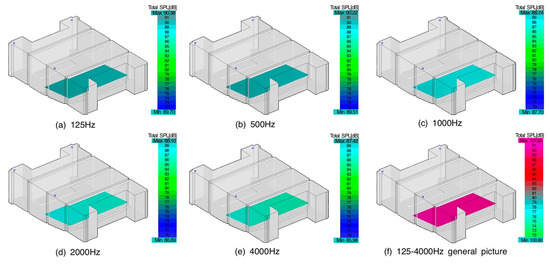
Figure 10.
Illustration of the sound pressure level of the measured surface under different frequencies.

Table 5.
Sound field uniformity analysis table.
Obviously, the sound field distribution in this academic lecture hall is relatively uniform under all frequency conditions (the unevenness is very small < 2 dB). Therefore, when the sound pressure levels from 125 to 4000 Hz are mixed and superimposed, the full-band modal distribution of the academic lecture hall shows a change of less than 8 dB (unevenness), and the minimum total sound pressure level is 100.8 dB. This performance exceeds the acoustic characteristic indicators specified in the national standards for conference-level sound reinforcement systems—the rated passband maximum sound pressure level (Max SPL) requirement of more than 98 dB and the stable sound field distribution standard of less than 8 dB at 1000 and 4000 Hz were exceeded.
3.2.2. Loudness Measurement
To validate the accuracy of the computer software simulation results, loudness field measurements were conducted at nine selected points within the academic lecture hall, as depicted in Figure 3. Utilizing stage-independent speakers and the AUDIO BASIK sound system, the hall’s empty-field loudness was assessed. The test results in Table 6 indicate a strong consistency between the field measurement data and the simulation analysis, affirming a uniform distribution (uniformity) of the sound field within the hall.

Table 6.
Measured loudness at points.
Its sound pressure level (SPL) and unevenness (or uniformity) meet the requirements. Within this consideration range, the loudness index is qualified. The main reason the volunteers could not hear clearly was not the loudness factor in this case.
3.3. Reverberation Time
Reverberation time stands as a fundamental attribute of the indoor sound field, wielding considerable influence over the quality of indoor acoustics. The factor of reverberation time is mentioned in the World Health Organization (WHO, 1999) [10] and the Architectural Institute of Japan (Fukuchi & Ueno, 2004) [11]. Meanwhile, Mike Barron [33], Brunskog [37], Alibaba [38] and Adekalu [39] found that the unreasonable reverberation time of lecture halls would have a certain adverse effect on the sound quality of the room. Reasonable reverberation time can help lecture halls achieve more excellent acoustic effects. Given its significance, reverberation time assessment assumes paramount importance in the endeavor to construct an optimal lecture hall environment [40].
Determination of Reverberation Time and Measured Values
The decay of sound within a room following the cessation of sound emission by the source is termed the reverberation process [41]. This duration significantly impacts the audience’s auditory experience. To calculate the reverberation time of the academic lecture hall, factors such as the room’s function, volume, interior surface absorption, relative humidity of the air, temperature, and other influencing parameters are considered. Eyring’s formula is frequently employed for this purpose, providing a comprehensive framework for reverberation time estimation.
- where V is the room volume, m3;
- K is a constant related to the speed of sound, generally taken as 0.161;
- S is the total surface area of the room, m2;
- is the average room sound absorption coefficient, calculated as:
We employed the AIWA AWA6290 Building Acoustic Measuring Instrument (a measurement system that can support reverberation time measurement, sound absorption coefficient measurement, airborne acoustic isolation measurement, floor impact sound measurement, and the sound quality measurement of the hall) to conduct the reverberation time test and evaluate the academic lecture hall (Figure 11).
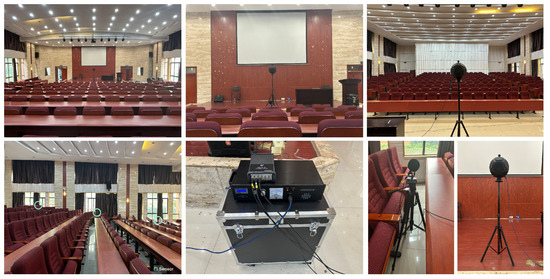
Figure 11.
On-site test equipment layout.
During the measurement of reverberation time, the auditorium was unoccupied, and an acoustic pulse was detected at the speaker’s position (where the speaker would sit during the conference) using a microphone placed at a height of 1.50 m. Receivers (at a height of 1.2 m) were positioned at various locations throughout the hall, evenly distributed across nine different spots. The positions of the sound source and receivers are illustrated in Figure 3 and Figure 11.
The theoretical and actual reverberation times for the lecture hall are shown in Figure 12. The calculation of the theoretical reverberation time for each frequency using EASE 4.4 revealed that the reverberation time in each frequency band exceeds the standard value, indicating a lack of acoustic treatment in this academic lecture hall.
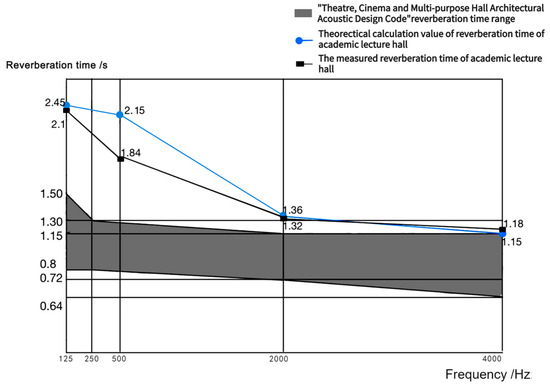
Figure 12.
Differences between theoretical value simulation, field test results, and value in GB/T50356-2005 [14] of reverberation time.
The actual results of the measurement indicated that the average reverberation time of the measurement points did not meet the requirements set out in the “Theatre, Cinema and Multi-purpose Hall Architectural Acoustic Design Code (GB/T50356-2005)” [14] for an academic lecture hall. This indicates that there is an urgent need to improve the acoustic absorption problems.
Through the simulation and measurement of the speech intelligibility, loudness, and reverberation time of this hall, combined with the calculation of the specification, it is found that it meets the requirements of loudness, but there are problems of low speech intelligibility and the non-compliance of reverberation time. Based on the formula proposed by Rao Yu’an [42],
- where T is the reverberation time;
- S is speech intelligibility;
- R is the different acoustic ratios (room constant);
From the above, it can be concluded that the speech intelligibility (S) in the reverberation field is inversely proportional to the logarithm of the (TR) product; that is, reducing the reverberation time in the lecture hall can effectively improve the speech intelligibility inside the lecture hall. Therefore, this article mainly proposes relevant acoustic modification plans for the reverberation time problem in the lecture hall.
4. Results and Retrofit Solution
Due to the problem that different types of sound-absorbing materials have different sound absorption coefficients and the update speed of sound-absorbing materials changes with each passing day, this study did not compare the different types of sound-absorbing materials. Instead, computer simulation methods are used to predict the appropriate locations for using sound-absorbing materials and imported into the architectural acoustics software EASE. The acoustic performances are then calculated based on different acoustic parameters such as material and location, to predict the impact on speech metrics where sound-absorbing materials should be placed in the room. From the aspect of reducing the quantity of sound-absorbing materials and thus the proper placing of building materials, a feasible renovation plan is proposed for the indoor acoustic environment of the existing lecture hall.
Kawata [43] suggested that acoustic materials should be distributed over at least two surfaces of a room to achieve acceptable acoustic conditions for speech intelligibility. Based on previous studies [44], this experiment applied acoustic materials to the acoustic performance of the rear wall, front ceiling, and rear ceiling. The acoustic absorbing materials were placed and tested in three steps as shown in the following figure (Figure 13).
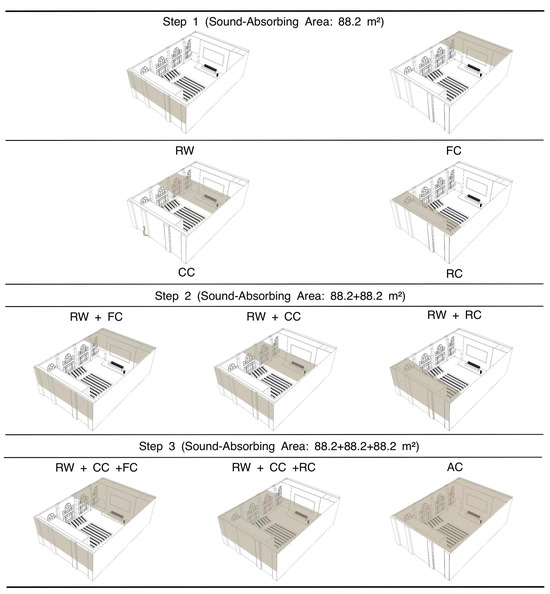
Figure 13.
Sound-absorbing material layout plan at different locations.
Step 1: Sound-absorbing materials with an area of 88.2 m2 were applied to the rear wall (RW), front ceiling (FC), middle ceiling (CC), and rear ceiling (RC) to compare their acoustic performance.
Step 2: Based on the results of step 1, we set the sound-absorbing material on the RW. And 88.2 m2 of sound-absorbing material was applied to FC, CC, and RC, respectively, and the acoustic performance of the three spatial combinations of RW + FC, RW + CC, and RW + RC was compared.
Step 3: Based on the results of step B, we applied sound-absorbing material to RW and CC. Then, we set 88.2 m2 of sound-absorbing material on FC and RC, respectively. We compared the acoustic performance of RW + CC + FC, RW + CC + RC, and the ceiling part (AC = FC + CC + RC).
Through calculation, we found that in step 1, the shortest reverberation time was obtained at RW. In step 2, the method RW + CC obtained the shortest reverberation time. In step 3, the method RW + CC + FC obtained the shortest reverberation time. The current measured values on-site (MEAS) are also shown in Figure 14.
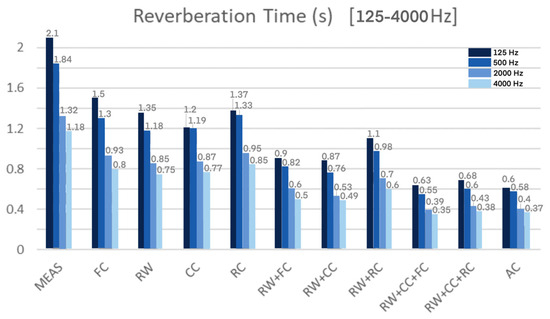
Figure 14.
The influence of the setting position of sound-absorbing materials on the reverberation time.
In summary, we found that the best sound absorption effect is obtained when the sound-absorbing material is applied to the rear wall, followed by the center, front, and rear of the ceiling. Therefore, when limited material updates are being made, the lecture hall should prioritize the use of sound-absorbing materials on the back wall to obtain higher clarity. In terms of multi-position combination arrangements, the combination of rear wall + ceiling center + ceiling front (RW + CC + FC) is the most efficient, exceeding the traditional combination of full ceiling (AC) and full rear (RW + CC + RC). This idea deserves more trials and field research.
5. Conclusions and Discussion
A multi-purpose lecture hall known for its space-saving features faced a flood of feedback about poor acoustic performance. This study takes the lecture hall of the School of Architecture and Planning of Yunnan University as an example to explore the possibility of improving the acoustic environment performance through spatial layout optimization from the perspective of architectural design. Through a combination of experimental testing and computer software simulation, the research deeply explored three key objective parameters for evaluating the sound quality of academic lecture halls: speech intelligibility, loudness, and reverberation time, and summarized the acoustic environment of the academic lecture hall in design problems. According to this, it was found that the main obstacle to the unclear hearing problem reported by students lies in the design and control of reverberation time. Software simulation is then used to determine the optimal location for sound-absorbing material placement, and the reverberation time can be controlled within the range required by the specification while using the better spatial distribution of sound-absorbing materials. At the same time, in conjunction with other optimization methods, strategies to optimize the acoustic environment of the academic lecture hall are proposed to better meet the needs of use.
Nonetheless, there are still several domains that necessitate further refinement. Firstly, despite numerous studies indicating that computer simulations can precisely undertake architectural acoustic investigations, an on-site comparative experiment would constitute a valuable adjunct. However, the implementation of the upgrade project, based on the findings of this study, will require a considerable duration to finalize, thus postponing the before–after comparison until its completion, which constitutes a significant limitation of this research.
Secondly, the activation of numerous electronic devices (e.g., air conditioning and lighting systems) complicates the actual conditions of the venue beyond the ideal scenario. The human body, acting as a sound absorber, and the low murmur of crowds have the potential to skew the actual audience effects derived from the research. It is noteworthy that the volunteers engaged in this study were young students, possibly introducing variations in auditory perception across different demographic groups.
In conclusion, the findings of this study, alongside the results of future investigations conducted within these constraints, are anticipated to serve as a reference for the establishment of regional standards in campus hall acoustic environment design.
Author Contributions
Conceptualization, Y.-N.Y. and J.Z.; methodology, X.-H.X. and J.-R.S.; software, X.-H.X. and J.Z.; validation, Y.-N.Y., W.J. and Y.S.; formal analysis, J.-R.S. and J.Z.; investigation, Y.-X.L. and J.-C.Z.; resources, Y.-N.Y., J.Z. and X.-P.W.; data curation, Y.-N.Y., W.J. and Y.S.; writing—original draft preparation, Y.-N.Y., J.Z. and X.-H.X.; writing—review and editing, Y.-N.Y., J.Z. and Y.S.; visualization, W.J.; supervision, Y.-N.Y., W.J. and Y.S.; project administration, Y.-N.Y., W.J. and Y.S.; funding acquisition, Y.S. All authors have read and agreed to the published version of the manuscript.
Funding
This research was funded by the National Natural Science Foundation of China, grant number 51668066; Key Laboratory of New Technology for Construction of Cities in Mountain Area: LNTCCMA, grant number 20230103; Yunnan University, grant number 2023Y43; Yunnan University, grant number 202301138; and Yunnan University, grant number 202307058.
Data Availability Statement
Data provided in this article are supported by experimental results and by the mentioned references.
Acknowledgments
The authors wish to express their sincere gratitude to Yunnan University, Technical University of Berlin, Huazhong University of Science and Technology, Korea University, and Hanyang Institute for their invaluable theoretical and technical support provided for this article. Additionally, we would like to express our heartfelt appreciation to Cui Lei from the Mathematics Department of Beijing Normal University for his invaluable technical support throughout this project and Johannes Reinders from TU Berlin for the proofreading.
Conflicts of Interest
The authors declare no conflicts of interest.
References
- Liang, H.; Huang, J. Research on the Architectural Design Positioning of University Halls. J. Archit. Res. Dev. 2021, 5, 25–32. [Google Scholar] [CrossRef]
- Bennett, P. University of Cincinnati: An Architectural Tour; Princeton Architectural Press: New York, NY, USA, 2001; pp. 57–59. [Google Scholar]
- Chen, X. Discussion on Environmental Design of Academic Lecture Halls in Higher Education. Ph.D. Thesis, Zhongnan University, Changsha, China, 2015. [Google Scholar]
- Wang, M.-Z. Sound Quality Design for Small and Medium-Sized Conferences and Lecture Halls. Ph.D. Thesis, Taiyuan University of Technology, Taiyuan, China, 2002. [Google Scholar]
- Tang, Z.-Q.; Lu, F.-H. Acoustical Environment Design of the Lecture Hall Based on the Improved Acoustic Index Analysis. Fresen. Environ. Bull. 2018, 27, 2922–2932. [Google Scholar]
- Budiaková, M. Problems of heating and ventilation in small university lecture hall. In Proceedings of the 8th International Scientific Conference Building Defects (Building Defects 2016), Ceske Budejovice, Czech Republic, 24–25 November 2016; EDP Sciences: Les Ulis, France, 2017; Volume 1. [Google Scholar] [CrossRef][Green Version]
- Bughio, M.; Schuetze, T.; Mahar, W.A. Comparative Analysis of Indoor Environmental Quality of Architectural Campus Buildings’ Lecture Halls and its’ Perception by Building Users, in Karachi, Pakistan. Sustainability 2020, 12, 2995. [Google Scholar] [CrossRef]
- Zhao, J. CFD Simulation Study of Airflow Organization in the Lecture Hall of the International Conference and Exhibition Center of Lanzhou Jiaotong University. Ph.D. Thesis, Lanzhou Jiaotong University, Lanzhou, China, 2015. [Google Scholar]
- Huang, H. Higher Education Lecture Theater. Master’s Thesis, Chongqing University, Chongqing, China, 2002. [Google Scholar]
- Berglund, B.; Lindvall, T.; Schwela, D.H.; WHO. Guidelines for Community Noise; WHO: Geneva, Switzerland, 1999. [Google Scholar]
- Fukuchi, T.; Ueno, K. Guidelines on acoustic treatments for school buildings proposed by the Architectural Institute of Japan. In Proceedings of the ICA—International Conference on Acoustic, Kyoto, Japan, 4–9 April 2004. [Google Scholar]
- AS/NZS 2107: 2016; Acoustics—Recommended Design Sound Levels and Reverberation Times for Building Interiors. Council of Standards Australia: Sydney, NSW, Australia; Council of Standards New Zealand: Wellington, New Zealand, 2016.
- DIN 18041; Acoustic Quality in Rooms-Specifications and Instructions for the Room Acoustic Design. Deutsches Institut für Normung: Berlin, Germany, 2016. [CrossRef]
- GB/T 50356-2005; Tongji University, Code for Acoustic Design of Theaters, Movie Theaters and Multi-Purpose Halls. Ministry of Construction of the People’s Republic of China, General Administration of Quality Supervision, Inspection and Quarantine of the People’s Republic of China: Beijing, China, 2005; p. 44.
- Nassiri, P.; Shalkouhi, P.J. Technical Note: Measurement of Background Noise Level and Prediction of Reverberation Time in University Classrooms. Int. J. Acoust. Vib. 2011, 16, 44–45. [Google Scholar] [CrossRef]
- Gómez Escobar, V.; Barrigón Morillas, J.M. Analysis of intelligibility and reverberation time recommendations in educational rooms. Appl. Acoust. 2015, 96, 1–10. [Google Scholar] [CrossRef]
- Pinho, P.; Pinto, M.; Almeida, R.; Lopes, S.; Lemos, L.T. Aspects concerning the acoustical performance of school buildings in Portugal. Appl. Acoust. 2016, 106, 129–134. [Google Scholar] [CrossRef]
- Sala, E.; Rantala, L.J. Acoustics and activity noise in school classrooms in Finland. Appl. Acoust. 2016, 114, 252–259. [Google Scholar] [CrossRef]
- Ricciardi, P.; Buratti, C. Environment, Environmental quality of university classrooms: Subjective and objective evaluation of the thermal, acoustic, and lighting comfort conditions. Build. Environ. 2018, 127, 23–36. [Google Scholar] [CrossRef]
- van den Heuij, K.; Goverts, T.; Neijenhuis, K.; Coene, M. Challenging listening environments in higher education: An analysis of academic classroom acoustics. J. Appl. Res. High Educ. 2021, 13, 1213–1226. [Google Scholar] [CrossRef]
- Astolfi, A. Premises for Effective Teaching and Learning: State of the Art, New Outcomes and Perspectives of Classroom Acoustics. Int. J. Acoust. Vib. 2023, 28, 86–97. [Google Scholar] [CrossRef]
- Wang, C.; Kang, J. Development of acoustic computer simulation for performance spaces: A systematic review and meta-analysis. Build. Simul. 2022, 15, 1729–1745. [Google Scholar] [CrossRef]
- Xie, H.; Zhou, C.; Liu, C. The effect of acoustic material arrangement on the sound field of a lecture hall. J. Acoust. Technol. 2022, 41, 691–696. [Google Scholar] [CrossRef]
- Wang, C. Characteristics and Prediction Model of the Sound Field and Crowd Noise in Extra-Large Spaces. Ph.D. Thesis, Tianjin University, Tianjing, China, 2018. [Google Scholar] [CrossRef]
- Wang, X.W.; Yan, X.; Hua, Y.F. Architectural Acoustic Renovation of the Lecture Hall of the Architecture Pavilion of Tsinghua University. In Proceedings of the 2017 National Acoustics Conference of the Acoustical Society of China, Harbin, China, 22 September 2017. [Google Scholar]
- Seeralaselvan, S.K. Acoustics Simulation for Stadium Design Using EASE: Analyzing Acoustics and Providing Retrofit Options for the Los Angeles Memorial Coliseum. Ph.D. Thesis, University of Southern California, Los Angeles, CA, USA, 2019. [Google Scholar]
- Iannace, G.; Berardi, U.; De Rossi, F.; Mazza, S.; Trematerra, A.; Ciaburro, G. Acoustic Enhancement of a Modern Church. Buildings 2019, 9, 83. [Google Scholar] [CrossRef]
- Lupea, I. Sound Absorption of Corrugated Cardboard Samples with a Simple Impedance Tube. Acta Tech. Napoc.-Ser. Appl. Math. Mech. Eng. 2020, 63, 347–352. [Google Scholar] [CrossRef]
- Shtrepi, L.; Prato, A. Towards a sustainable approach for sound absorption assessment of building materials: Validation of small-scale reverberation room measurements. Appl. Acoust. 2020, 165, 107304. [Google Scholar] [CrossRef]
- Berardi, U.; Iannace, G.; Di Gabriele, M. Characterization of sheep wool panels for room acoustic applications. Proc. Mtgs. Acoust. 2016, 28, 015001. [Google Scholar] [CrossRef]
- GB/T 20247-2006; Acoustic absorption measurement in the acoustic reverberation chamber. Standardization Administration of China: Beijing, China, 2006.
- Zhu, P.-S.; Tao, W.-Q.; Lu, X.-D.; Mo, F.-S.; Guo, F.; Zhang, H.-C. Optimisation design and verification of the acoustic environment for multimedia classrooms in universities based on simulation. Build. Simul.-China 2022, 15, 1419–1436. [Google Scholar] [CrossRef]
- Barron, M.; Kissner, S. A possible acoustic design approach for multi-purpose auditoria suitable for both speech and music. Appl. Acoust. 2017, 115, 42–49. [Google Scholar] [CrossRef]
- Iannace, G.; Ciaburro, G.; Trematerra, A.; Foglia, C. Acoustic Correction of a Renaissance Period Hall. Can. Acoust. 2019, 47, 57–66. [Google Scholar]
- Bradley, J.S.; Reich, R.; Norcross, S.G. A just noticeable difference in C50 for speech. Appl. Acoust. 1999, 58, 99–108. [Google Scholar] [CrossRef]
- Sato, H.; Morimoto, M.; Sato, H.; Wada, M. Relationship between listening difficulty and acoustical objective measures in reverberant sound fields. J. Acoust. Soc. Am. 2008, 123, 2087–2093. [Google Scholar] [CrossRef] [PubMed]
- Brunskog, J.; Gade, A.C.; Bellester, G.P.; Calbo, L.R. Increase in voice level and speaker comfort in lecture rooms. J. Acoust. Soc. Am. 2009, 125, 2072–2082. [Google Scholar] [CrossRef] [PubMed]
- Alibaba, H.Z.; Ozdeniz, M.B. Acoustical renovation of university multipurpose halls: The case of lala mustafa paşa hall. Sustainability 2019, 11, 1397. [Google Scholar] [CrossRef]
- Adekalu, O.B.; Alibaba, H.Z. Achieving Acoustic Comfort in the Architectural Design of a Lecture Hall. Int. J. Civil. Struc. Eng. Res. 2018, 6, 161–184. [Google Scholar]
- Bistafa, S.R.; Bradley, J.S. Reverberation time and maximum background-noise level for classrooms from a comparative study of speech intelligibility metrics. J. Acoust. Soc. Am. 2000, 107, 861–875. [Google Scholar] [CrossRef] [PubMed]
- Leccese, F.; Rocca, M.; Salvadori, G. Fast estimation of Speech Transmission Index using the Reverberation Time: Comparison between predictive equations for educational rooms of different sizes. Appl. Acoust. 2018, 140, 143–149. [Google Scholar] [CrossRef]
- Rao, Y.-A. Experimental and theoretical calculations on the acoustic ratio-reverberation time-speech intelligibility relationship. J. Acoust. 1981, 20–33. [Google Scholar] [CrossRef]
- Kawata, M.; Tsuruta-Hamamura, M.; Hasegawa, H. Assessment of speech transmission index and reverberation time in standardized English as a foreign language test rooms. Appl. Acoust. 2023, 202, 109093. [Google Scholar] [CrossRef]
- Lee, S.-M.; Haan, C.-H. Determination of the Sound Absorption Area Inside an Elementary Classroom Using Three Acoustical Methods: Computer Modeling, 1/10-Scale Model Experiment, and Field Acoustic Measurement. Buildings 2024, 14, 222. [Google Scholar] [CrossRef]
Disclaimer/Publisher’s Note: The statements, opinions and data contained in all publications are solely those of the individual author(s) and contributor(s) and not of MDPI and/or the editor(s). MDPI and/or the editor(s) disclaim responsibility for any injury to people or property resulting from any ideas, methods, instructions or products referred to in the content. |
© 2024 by the authors. Licensee MDPI, Basel, Switzerland. This article is an open access article distributed under the terms and conditions of the Creative Commons Attribution (CC BY) license (https://creativecommons.org/licenses/by/4.0/).